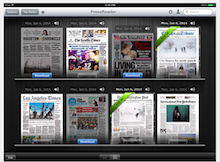In October 2012, just 23 percent of Americans told Pew they read even one newspaper the previous day. So who in the world could possibly want or need unlimited access to 2,500 of them?
Alex Gruntsev, EVP and chief innovation officer of PressReader, made a compelling case in a phone interview that his “Netflix-style” subscription service — $29.95 per month — fills a niche in online news publishing by presenting news in a form that many automated aggregators cannot.
PressReader, formerly NewspaperDirect, has long provided PDF replicas mainly as a specialty business, but now it’s focusing on a wider consumer audience. “For just your morning routine, to open a PC was difficult,” Gruntsev said. “But in 2010, with the first iPad, the experience of reading dramatically changed, and it became way more appealing to the average reader.”
Now, PressReader users online or on tablets don’t just get static images of newspaper pages; they can jump into individual stories by clicking headlines. That launches PressReader’s SmartFlow mode, which allows for a seamless stream of stories scrolling left to right.
That’s in contrast to the “flop” method of consuming news on the web, Gruntsev said, where readers must jump into a story and then jump back to a homepage or index page for another one. That back-and-forth method of navigation leads to readers only viewing an average of three to five stories per day. Newspapers, meanwhile, allow for more linear navigation, leading to 20 stories seen by the average reader, Gruntsev said.
(For research into newspapers’ ability to engage readers longer and more deeply, see this report by the Readership Institute at Northwestern University and this one [PDF] from the University of Oregon highlighted by Jack Shafer when he was at Slate.)
The New York Times’ web app, Today’s Paper, achieves something close to the story flow of PressReader, but every story in the Times app looks the same. There’s no variety in headline size or photo size, the other big advantage of PressReader, according to Gruntsev. The layout engine, which required three years of development, converts print pages into one long stream of stories that takes into account editorial judgments, the visual cues that signal to readers that certain stories are more important than others.
That variety in presentation style also is intended to keep readers engaged better than the “flip” method, employed by various newspaper apps aggregators like Flipboard, which allow readers to jump from story to story without a menu but, again, offer stories that all tend to look the same. That makes readers lose interest quickly, Gruntsev claims. And to an extent I’ve felt that Flipboard fatigue myself: At some point, it becomes difficult to decide what to read when, for instance, every story card in Zite looks exactly like the others.
PressReader’s SmartFlow may not be as beautiful as other apps are, but it aims to mimic the visual hierarchy carefully crafted by newspaper designers. Readers instantly get a good sense for what editors deemed important, and it’s easier to judge whether stories are worth reading by browsing through full stories in a flowing format than by picking from dozens of headlines.
Analytics-powered aggregation
PressReader’s also leveraging its PDF replica readership to create a new kind of smart aggregation. The service can track which stories — and even which quadrant of the print replica pages — readers are most drawn to. Then, it reassembles stories from different newspapers into one collection of the day’s top stories. This feature is only available online for now, but Gruntsev noted how the industry seems to be focusing on web apps and moving away from native apps.
Will this type of aggregation surface more engaging content than social media or other smart aggregators like Zite that are so good at taking into account individual preferences? On Sunday night it definitely didn’t, as top stories at PressReader.com included a recap from a day-old NFL playoff game and a preview of one that had ended a few hours before I visited the site. With only the morning’s newspaper content to draw from, PressReader — even with so many newspapers available — can only feel timely and relevant for so long.

- PressReader offers unlimited access to a wide selection of popular newspapers from around the world for $29.95 per month. Individual issues are available via in-app purchases.
As a newspaper nerd, I get a kick out of being able to flip through so many newspapers from around the world. But for the average consumer, access to thousands of newspapers is different from access to thousands of movies. (Gruntsev points out that access to the average newspaper website’s paywall costs around $15 per month, so in theory PressReader makes sense for anyone interested in two or more newspapers per day. And some newspapers bundle access to PressReader issues with their digital subscriptions.)
Still, the interface isn’t visually compelling enough to make me a loyal reader, and the lack of timeliness will alienate readers actively involved in social media. But it’s gratifying to see a digital service apply lessons from a piece of technology that has served us so well.







